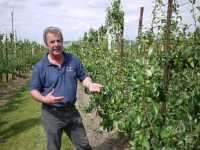Growing With A European Flair

If there was a theme to the recent International Fruit Tree Association (IFTA) 2011 Summer Study Tour to Europe July 25-30, it might be: homage, nursery, and pears. Homage for the time we spent in East Malling, Great Britain home of the Malling series of rootstocks that forms the true basis of our modern apple growing industry; nursery for the two impressive tree fruit nurseries we visited in Holland and Belgium; and pears for the fact they grow more pears — and from what we saw, very successfully — than apples in Belgium.
First stop for the nearly full bus load of growers, researchers, industry, and Extension personnel from the U.S., Canada, Mexico, Australia, and Korea was a full day at East Malling Research (EMR).
Once government and industry supported, EMR has evolved to financially support itself and now relies on a combination of industry, grants, trust funds, and a conference center to do research, outreach, and host events. All was adequately explained during indoor presentations by various EMR staff, including Dr. Peter Gregory, recently hired as director of EMR. He emphasized core research capabilities of the research station, including genomics, pest management, postharvest physiology, and general crop management with “sustainable increased production of horticultural (primarily perennial fruit) crops” as the main objective. You should know that EMR is home to the Malling series of apple rootstocks, where Sir Ronald Hatton first classified them, including M.IX (M.9).
Outdoors we toured research by EMR scientists, including organic apples, biological pest control, irrigation management, and strawberry breeding. (Strawberry season was ongoing, so we were able to savor some of their selections — a delicious treat!) A “Concept” Pear Orchard was perhaps a highlight, with four planting systems explained (pros and cons) by EMR orchard manager Graham Kaspell.
For the next two days, we toured four orchards in the countryside surrounding the city of Maidstone (southeast of London, on the way to the Channel crossings by tunnel or ferry.) Among them were dwarf cherry orchards, a large orchard specializing in Bramley apples, a “Concept” apple orchard, and a successful organic apple, pear, winegrape, and hops farm. We also managed to fit in an evening in Whitstable for the Oyster Festival, a visit to medieval Leeds Castle, leisure time in the cathedral city of Canterbury, and a wonderful group dinner at the Bradbourne House, hosted by Will Sibley of the East Malling Trust for Horticultural Research.
After crossing the English Channel (by train in a tunnel) we spent a day each in Holland and Belgium. Both countries featured a stop at a major fruit tree nursery, Verbeek Nursery in Holland and Carolus Trees in Belgium. Europe-grown two-year-old “knip-boom” trees are legendary for their quality and pricing, and neither nursery disappointed. At Carolus, Koen Carolus took the opportunity to explain his one-year “sprinter” trees, too, which through continuous fertigation, he claims can grow to nearly the quality of a two-year-old knip-boom tree in one year only.
In Holland we also visited the cherry and apple orchards of Elenbaas Farm, including significant acreage with Voen rain covers. And in Belgium, Carolus showed us his fruiting wall fruit management system for producing apples, which he claims can increase production of medium-quality apples while reducing labor costs through mechanical hedge pruning and fruit thinning with the Darwin string thinner.
In both countries we also visited and saw plenty of pear orchards. In fact, as mentioned, there are more pears than apples grown in Belgium (They’re not called “European pears” for nothing!). But, as one attendee put it, the “Uber!” pear orchard was found in Holland, where manager Jans van Dyck toured us around a perfectly manicured, 20-acre pear-only orchard. Here, yields of 1,300 40-pound boxes per acre of the popular Conference pear are expected. A key to achieving these yields is the dwarfing Quince rootstock, which unfortunately is apparently not winter hardy for us here in North America.
The end of our tour was at the PCFruit research complex near Sin-Truiden, Belgium, where a combination of industry, government, grants, and grower support fuels a successful business of research directed to growers with expertise in crop protection. Before most of us returned to England for flights home, we had a free night in Brussels to explore the city and view the spectacular evening light show in the Grand Place, the central square of Brussels, and voted the most beautiful square in Europe. Not one of us dissented.
Mark you calendar for the IFTA Conference in Chile, January 9-12, 2012.
For more coverage and photos, click here.










